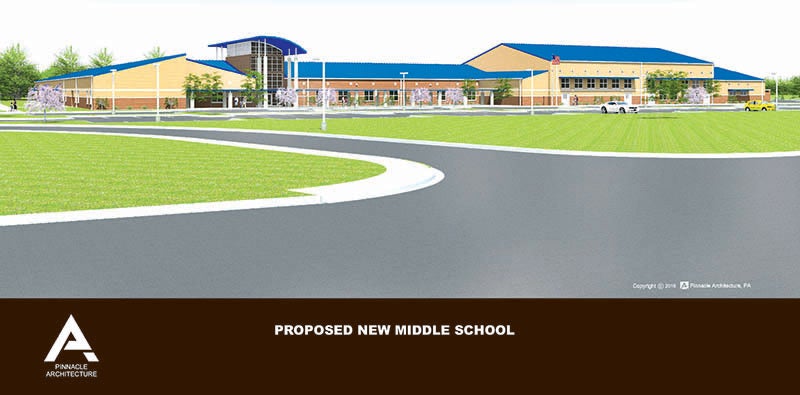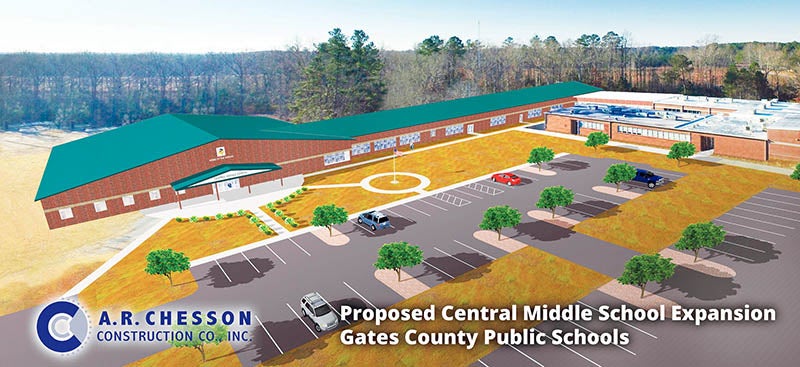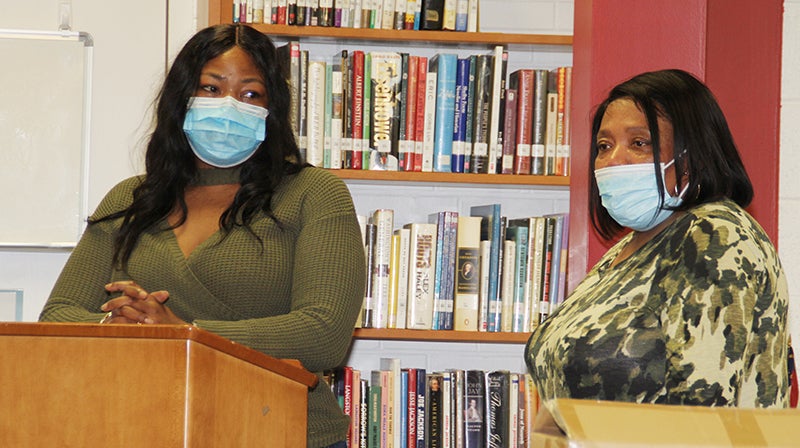Another option
Published 10:05 am Thursday, January 19, 2017
GATESVILLE – Back in November, the voting citizens of Gates County defeated a referendum that called for a 12-cent increase in the property tax to build a new $16 million Central Middle School.
Now, there is another plan on the table….one that may spend one-half that amount on the school project and possibly not increase the property tax more than three to four pennies thanks to some new money coming to the county via state sales tax.
While this possible new project still has a few hurdles to clear, it was part of the discussion at a workshop held by the Gates County Commissioners on Jan. 11 at the courthouse.
That discussion led off with a reference to the county’s current debt, which now totals a little over $951,000. The majority of that is used to make annual payments on the DSS building. Another $5 million remains on the books until 2022 to pay-off the most recent renovation/new construction projects at several schools, while the debt service on the public library will be settled in two months (an annual payment of $152,000).
Board chairman Linda Hofler pointed out that the LGC (Local Government Commission) lists Gates County’s maximum limit of debt service payments at $1.65 million. That number is based on a county not borrowing more than 15 percent of its total General Fund. In Gates County’s case, their current General Fund is approximately $11 million.
“I do not want to see us get close to that maximum (debt service limit),” said Hofler.
She added that if the commissioners move forward with building or renovating Central Middle School, the money needed for that project, as well as other required information (to include permitting and environmental data on the site plan), has to be approved by the LGC.
The board studied all six construction/renovation options as presented at their Jan. 4 meeting by Gates County Superintendent Dr. Barry Williams.
“My feelings on this is that we are mandated, by general state statutes, to provide sufficient educational facilities for the county,” said Commissioner Henry Jordan. “Whether or not we can determine that the school system has done all they can do to upkeep these facilities, we can only take them at their word. They say that Central Middle is now in such a state where something has to be done.”
Among the options presented, Jordan said he favored option #2 as submitted by Pinnacle Architecture. That plan calls for demolition and reconstruction of the administration, 8th grade wing, and gymnasium, and renovate the 7th grade wing.
This option keeps the current sixth and seventh grade buildings. Additionally the existing cafeteria will be utilized. New construction consists of an eighth grade wing, gymnasium, locker rooms, media center, music/band room, art room, group toilet, teacher work room and an administrative area including guidance and student support services.
The existing seventh grade wing will be renovated. It may include an upgraded HVAC system, floor coverings, lighting, windows and doors. The existing sixth, seventh grades areas along with the cafeteria will be painted.
Pinnacle estimates the cost for option two at $7,998,400.
To pay for that option, Jordan said the county could borrow $6 million by way of an interest free Qualified School Construction Bond and $2 million in the form of an interest free Qualified Zone Academy Bond. The annual debt service payment, based on a 15-year payback, would be $400,000 per year. That would require a property tax hike of six cents (per $100 of value) to cover those loans, which have been pre-approved by the North Carolina Department of Public Instruction, according to Dr. Williams.
“This is based on if we can borrow this money with no interest,” Jordan said. “We would not come close to exceeding our debt service limit.”
Commissioner Billy Felton said while he was aware of the issues at Central Middle School, he has some concerns.
“We ask for a plan back in July and the idea was to have a voter referendum to let our citizens decide whether or not to build a new school,” Felton said. “The people of our county said no (in defeating the referendum by a 56-to-44 percent margin). Now we’re putting some window dressing on this and bringing it back up again…..we’re not paying attention to what the taxpayers said. I have a hard time going against what our people say.”
Felton also stated that he had asked for a prioritized list of the problems at the middle school.
“We do not have that,” he said. “What I would like to see before we go spending eight million dollars is a prioritized list of the problems at the school and fix them in an orderly fashion so this does not put such a tax burden on our citizens.”
Another concern for Felton is the failure of county school officials of supplying an overall plan for the needs of all schools in the county.
“We asked for a five-to-10 year vision plan, and still do not have it,” Felton noted. “If we commit these funds to the middle school and then within the next 15 years T.S. Cooper (Elementary School) falls down, what do we do? We need to look at the whole picture.”
Hofler agreed with Felton.
“We have problems at all of our schools,” she remarked. “Certainly we can’t fix those problems all at one time. What’s going to happen at our other schools when we’re paying back the loan to fix the problems at the middle school and we’re at or near the limit of how much money we can borrow?”
Commission Vice Chairman Jack Owens said he visited the school on the afternoon of Jan. 4 and was taken on a “walk-thru” by the principal.
“It wasn’t raining that day, but there were five buckets out in various places catching water,” Owens said, “including one in a classroom occupied by students at the time I was there.”
Owen said he is concerned over conflicting comments about the current load-bearing walls/beams at the school.
“One person says the walls are solid; another says there are not,” he said. “We need someone with a higher (building inspection) certification to inform us of those walls as well as the other detailed needs there. What if there are new discoveries (during the inspection) that cause the renovation and new construction to exceed the money we’re talking about.”
Jordan said he feels that even though no litigation has been brought against the county at this point by the parents of the middle school students over the presence of mold and other issues, there have been “whispers” of possible legal action.
“If we do nothing, does that mean we’re negligent,” he asked.
“If we have $700,000 of room on our debt service, if we agreed to not go over $400,000 (in annual payments) and keep the tax increase at six cents or less, can we make this (project) happen” Owens asked his colleagues.
It was at this point where County Manager Natalie Rountree spoke up about possibly applying the new distribution method of the state sales tax that the county recently began to receive to help offset the annual debt service on the middle school project.
“We are getting money from a newly created formula approved by our General Assembly that aids smaller, rural counties like us,” Rountree said. “The only stipulation on this redistribution of state sales tax is that this new money can only be used for public schools, economic development or the community college.”
She said this redistribution of sales tax means approximately $46,000 to $48,000 more for Gates County each month. The down side is that the longevity of this redistribution plan is unknown, since it involves politics at the state level.
“We did not budget these new funds because we were not comfortable of how this new distribution formula would affect us, plus you never know when the state legislators may decide to do away with it or drastically change it,” Rountree stated.
This approximate $550,000 of unbudgeted money could be used annually to make the debt service payments should the commissioners decide to borrow the money and use it for option #2 plan as submitted by Pinnacle Architecture.
“Based on these funds, we would not need to raise taxes to pay for the school construction/renovation,” Jordan remarked.
However, Hofler warned there remains other needs in the county, citing that solid waste is still running a deficit plus the previously mentioned needs at other schools.
“We could cut back on the tax increase,” Hofler said.
“With this reallocation of the sales tax, we could delay any possible tax increase until next year; that gives us some time to weigh what our other needs are and the money needed for those,” Jordan chimed in. “If we do decide to raise taxes, I’m thinking more in the three to four cents range, no where close to the 12 cents the voters turned down in the referendum.
“Plus we’re taking $152,000 off the books in March when we pay off the library. I feel the timing is right; this is a great opportunity to fix Central Middle School.”
“The vote is the vote, but I feel we need to do what’s right,” Owens said, also referencing the plans at the school. “If we do proceed, it will be perceived that we’re going against what the majority of our citizens said on election day.”
“I agree, but we can’t overlook our obligations to provide a safe and healthy environment for our schoolchildren,” Jordan stressed.
In the end, the commissioners directed Rountree to devise a step-by-step plan, following the requirements of the LGC, of what was needed to possibly use Pinnacle Architecture’s option #2 at Central Middle School.
No vote was taken at the workshop. More details may surface at the board’s regularly scheduled meeting that was scheduled last night (Wednesday).





